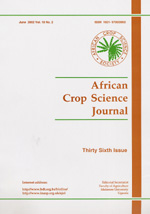
|
African Crop Science Journal
African Crop Science Society
ISSN: 1021-9730
EISSN: 1021-9730
Vol. 28, No. 4, 2020, pp. 499-515
|
 Bioline Code: cs20058
Bioline Code: cs20058
Full paper language: English
Document type: Research Article
Document available free of charge
|
|
|
African Crop Science Journal, Vol. 28, No. 4, 2020, pp. 499-515
| en |
Phenotypic diversity and chemical properties of pawpaw fruit quality in Ugandan germplasm
Nuwamanya, E.; Ampurire, O.; Mukasa, Y.; Katungisa, A.; Kanaabi, M. & Sserunjogi Mukiibi, E.
Abstract
Pawpaw (Carica pawpaw L.) fruit production and utilisation have been on the increase in Uganda. However, challenges related to identification of phenotypes with inherent characteristics for improvement of fruit shelf life have limited identification of better varieties. The objective of this study was to evaluate the phenotypic diversity and shelf life determinants of Uganda’s pawpaw accessions and their variations based on selected quality parameters. Nineteen accessions were collected as seeds from different markets of Uganda, germinated and planted in Namulonge-Wakiso district, central Uganda. The accessions were significantly (P<0.05) variable in terms of fruit weight parameters, with dry matter ranging from 14 - 19% and fruit weight of up to 3.9 kg; while pulp weight was up to 3.2 kg per fruit. Pulp firmness parameters were also significantly variable (P<0.05) and highly correlated with shelf life of the fruit, which ranged from 7 - 13 days depending on the accession. Fruit pulp pH ranged from 4.4-5.6; while titratable acidity of the fruit ranged from 0.03-0.08%. The accessions were clustered in four main clusters depending on the fruit firmness properties, fruit shelf life, fruit weight, pH and titratable acidity as definitive parameters. These accessions were distinguished based on morphological parameters, and henceforth defined for nutritional and economic uses. Accessions with high fruit firmness (>5 kg F) such as 16/20’ 16/16, 16/17 and 18/1; and external pulp thickness (>2 cm) such as 16/16, 16/17 and 18/1 had improved fruit shelf life and are recommended for marketability and processing.
Keywords
Carica pawpaw; fruit firmness; morphology; nutrition
|
| |
| fr |
Nuwamanya, E.; Ampurire, O.; Mukasa, Y.; Katungisa, A.; Kanaabi, M. & Sserunjogi Mukiibi, E.
Résumé
La production et l’utilisation de fruits de papaye (Carica pawpaw L.) ont augmenté en Ouganda. Cependant, les défis liés à l’identification des phénotypes ayant des caractéristiques inhérentes à l’amélioration de la durée de conservation des fruits ont limité l’identification des meilleures variétés. L’objectif de cette étude était d’évaluer la diversité phénotypique et les déterminants de la durée de conservation des accessions de papaye en Ouganda et leurs variations en fonction de certains paramètres de qualité. Dix-neuf accessions ont été collectées sous forme de semences sur différents marchés de l’Ouganda, germées et plantées dans le Namulonge, district de Wakiso, à l‘ Ouganda centrale. Les accessions étaient significativement variables (P <0,05) en termes de paramètres de poids des fruits, avec une matière sèche allant de 14 à 19% et un poids des fruits allant jusqu’à 3,9 kg; tandis que le poids de la pulpe atteignait 3,2 kg par fruit. Les paramètres de fermeté de la pulpe étaient également significativement variables (P <0,05) et fortement corrélés à la durée de conservation du fruit, qui allait de 7 à 13 jours selon l’accession. Le pH de la pulpe de fruit variait de 4,4 à 5,6; tandis que l’acidité titrable du fruit variait de 0,03 à 0,08%. Les accessions ont été regroupées en quatre groupes principaux selon les propriétés de fermeté du fruit, la durée de conservation du fruit, le poids du fruit, le pH et l’acidité titrable comme paramètres définitifs. Ces accessions ont été distinguées sur la base de paramètres morphologiques, et définies à la base des usages nutritionnels et économiques. Les accessions à forte fermeté du fruit (> 5 kg F) telles que 16/20 ’16/16, 16/17 et 18/1; et une épaisseur de pulpe externe (> 2 cm) telle que 16/16, 16/17 et 18/1 avaient une durée de conservation améliorée des fruits, et elles sont recommandées pour la commercialisation et la transformation.
Mots Clés
Carica papaye; fermeté du fruit; morphologie; nutrition
|
| |
© Copyright 2020 - African Crop Science Society
|
|
